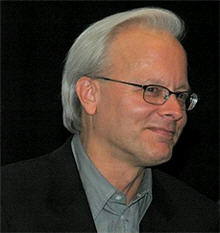Where in the world is Ray Ozzie?


Ozzie, who joined Microsoft in March of 2005, is keeping a low profile lately.
The last time he gave a major public address was at the MIX 07 conference in April of this year, rolling out the Microsoft's AIR/Flash competitor Silverlight. He did speak at Microsoft's Financial Analyst Meeting in July, giving an update on the Live platform.
He hasn't posted on his Window Live Spaces blog, linked on his Microsoft bio page, since the spring of 2006. He used the blog to talk about new ideas, such as Simple Sharing Extensions and Live Clipboard.
Chairman Gates and CEO Steve Ballmer have been carrying the bulk of the high ranking Microsoft official public evangelist role. When Gates leaves his day-to-day ringmaster role in July 2008 to focus on the Bill & Melinda Gates Foundation, Ozzie will have to appoint someone to be the chief Microsoft software architect/evangelist or take on more of that role himself.
In terms of letting the software do the talking, Mary Jo Foley recently posted a kind of report card on Ozzie's efforts with Windows Live Services, which graduated from beta phase on Nov. 6, with availability in 36 languages and across 59 countries.
Blogging hero Mary Jo concluded: "Microsoft still has quite a way to go to make its Windows Live story truly intuitive and understandable by non-Microsoft-watchers. But compared to where the company was even a year ago, the Live team has come a long way.
Microsoft is hoping to funnel a good portion of the more than 400 million users of Hotmail and Messenger users into the additional Windows Live services. And, the company will likely use its Facebook relationship (investing $240 million and selling ads on the service) to market Windows Live.
In September Microsoft announced Office Live Workspace for consumers and small businesses. The company describes the services as “a new Web-based feature of Microsoft Office which lets people access their documents online and share their work with others.” It's not a Web-based set of Office applications.
Office Live, a set of services, not productivity apps as you might expect, for small businesses lacking IT support, currently has more than 350,000 customers worldwide.
Microsoft has also hatched Windows Live Community Builder, a service that appears similar to Office Live, that competes with Google Apps for Your Domain and includes several Windows Live services bundled together with administrative and customization capabilities.
However, unlike Google Apps (Docs, Spreadsheet and Presentations) Microsoft's Live offerings don't include productivity applications. Windows Live Writer, for example, is a downloadable blogging tool, not a cloud-based, collaborative word processor.
Microsoft has taking its time in delivering cloud-based applications, in part to avoid cannibalizing its $16 billion desktop office applications business with free or ad-supported, lighter-weight versions of Office.
Ozzie's strategy is to leverage the rich client legacy with companion online applications. He talks in terms of user scenarios and hybrid models that map to customer needs, rather than trying to mimic the Web-centric browser-based applications of what Google, Zoho, ThinkFree or even salesforce.com.
In bridging the gap between the old and new worlds, and leveraging Ozzie's extensive background in creating collaborative, networked applications, Microsoft is developing a Sync Framework for adding synchronization, roaming, and offline capabilities to applications, and using any data type, data store, transfer protocol, or network topology.
Google has developed Google Gears, an open source browser extension that gives Web applications offline, hybrid functionality via JavaScript APIs.
Last year at this time, Ozzie said:
"At the highest level–and I am really thinking at that level–we are in the productivity business. When I was a Lotus, I competed with Microsoft, and [at Microsoft] we have a well defined suite. There are new scenarios, and as a company we want to deliver what people want. Some scenarios are about documents, some are with sharing and collaboration, others are standalone or with SharePoint, and some are Web-based back-ends with a rich front end and some components are pure Web. There are scenarios for high bandwidth, mobile or sitting in front of a large screen."
At the Mix 07 event in April, Ozzie said regarding a cloud-based Office suite:
"[Office Live] will progressively broaden…we have no specific announcements today. In my opening remarks, I laid out a design pattern and you will see it replicated through the offerings we do. You use a PC for what a PC is good for and look at the overall scenario, what is best for the PC and what in services as standalone or in conjunction with a PC or mobile device. In all of our products can use that pattern to extrapolate."
On the other hand, Jeff Raikes, president of Microsoft's Business division, has said that customers aren't asking for an Office in the cloud. That may be the case broadly speaking, but a billion of users on Web who need to create and share documents is a very large addressable market, and Google is aggressively pursuing it with its growing set of communications and productivity applications.
At a meeting with financial analysts at Microsoft's Redmond, WA headquarters in July, Ozzie said regarding the rich client software + services model:
"We are the only company with a platform DNA to viably delivery this kind of highly leveraged platform approach to services and we're certainly one of the few companies that has the financial capacity to capitalize on this sea change."
Next year will be pivotal for all the players pushing office suites. Google and others will have bridged the gap from the online to offline with Google Gears. And Microsoft and Ozzie will likely cross the bridge, with a newly articulated scenario, and deliver a cloud-based, hybrid version of Office, or MicrosoftWorks, that completes the Windows to Web transformation.